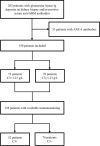Prognostic value of complement serum C3 level and glomerular C3 deposits in anti-glomerular basement membrane disease
- PMID: 37475859
- PMCID: PMC10354545
- DOI: 10.3389/fimmu.2023.1190394
Prognostic value of complement serum C3 level and glomerular C3 deposits in anti-glomerular basement membrane disease
Abstract
Background and objectives: Activation of the complement system is involved in the pathogenesis of anti-glomerular basement membrane (anti-GBM) disease. Glomerular deposits of complement 3 (C3) are often detected on kidney biopsies. The primary objective of this study was to analyze the prognostic value of the serum C3 level and the presence of C3 glomerular deposits in patients with anti-GBM disease.
Methods: We conducted a retrospective cohort study of 150 single-positive patients with anti-GBM disease diagnosed between 1997 and 2017. Patients were categorized according to the serum C3 level (forming a low C3 (C3<1.23 g/L) and a high C3 (C3≥1.23 g/L) groups) and positivity for C3 glomerular staining (forming the C3+ and C3- groups). The main outcomes were kidney survival and patient survival.
Results: Of the 150 patients included, 89 (65%) were men. The median [interquartile range (IQR)] age was 45 [26-64]. At diagnosis, kidney involvement was characterized by a median [IQR] peak serum creatinine (SCr) level of 578 [298-977] µmol/L, and 106 (71%) patients required dialysis. Patients in the low C3 group (72 patients) had more severe kidney disease at presentation, as characterized by higher prevalences of oligoanuria, peak SCr ≥500 µmol/L (69%, vs. 53% in the high C3 group; p=0.03), nephrotic syndrome (42%, vs. 24%, respectively; p=0.02) and fibrous forms on the kidney biopsy (21%, vs. 8%, respectively; p=0.04). Similarly, we observed a negative association between the presence of C3 glomerular deposits (in 52 (41%) patients) and the prevalence of cellular forms (83%, vs. 58% in the C3- group; p=0.003) and acute tubulo-interstitial lesions (60%, vs. 36% in the C3- group; p=0.007). When considering patients not on dialysis at diagnosis, the kidney survival rate at 12 months was poorer in the C3+ group (50% [25-76], vs. 91% [78-100] in the C3- group; p=0.01), with a hazard ratio [95% confidence interval] of 5.71 [1.13-28.85] (p=0.04, after adjusting for SCr).
Conclusion: In patients with anti-GBM disease, a low serum C3 level and the presence of C3 glomerular deposits were associated with more severe disease and histological kidney involvement at diagnosis. In patients not on dialysis at diagnosis, the presence of C3 deposits was associated with worse kidney survival.
Keywords: C3 glomerular deposits; anti-glomerular basement membrane disease; complement C3; kidney biopsy; kidney prognosis; kidney survival.
Copyright © 2023 Caillard, Vigneau, Halimi, Hazzan, Thervet, Heitz, Juillard, Audard, Rabant, Hertig, Subra, Vuiblet, Guerrot, Tamain, Essig, Lobbedez, Quemeneur, Legendre, Ganea, Peraldi, Vrtovsnik, Daroux, Makdassi, Choukroun and Titeca-Beauport.
Conflict of interest statement
The authors declare that the research was conducted in the absence of any commercial or financial relationships that could be construed as a potential conflict of interest.
Figures




References
MeSH terms
Substances
LinkOut - more resources
Full Text Sources
Miscellaneous

